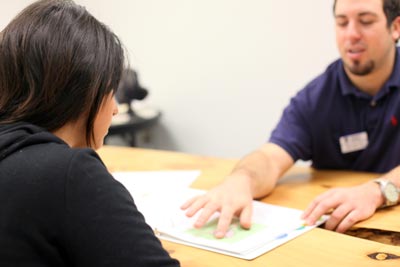At a long wooden table in the Speech, Language and Hearing Clinic’s Juniper Room, Northern Arizona University graduate student Chase Larsen sits across from his past. And freshman Lindsay Muto peers back, hoping to see her future.
Each of them is “a person who stutters”—an intentional description that avoids the negative label of “stutterer.” On this day, Larsen and fellow grad student Naomi Brandis—both in the Clinical Speech-Language Pathology program—will work with Muto in a therapy session that is as much about dispelling fears and building confidence as it is about cultivating linguistic fluency.
Associate professor Judy King, who is overseeing the session from behind an observation window, points out the emotional responses that charge the room, and which escape the awareness of most people.
King said her message to clients is that “You are many things, but stuttering doesn’t define you.” For people who stutter, she said, “there are feelings and attitudes below the surface, such as fear, shame and isolation.”
Muto has been through therapy on and off throughout her life, but “this is the first setting where her feelings and attitudes are being dealt with,” King said.
|
Larsen knows the feeling. He also experienced on-and-off therapy and entered NAU as an undergraduate “flying under the radar.” That changed when he encountered King in grad school, who told him he needed to get into intensive therapy after hearing him read a passage in voice testing.
“It was like nothing I had ever done before,” Larsen said. “In the last eight months, I made more progress than in the previous eight years.”
What Larsen learned, besides confidence, was how to use strategies to get him past blocks. Now he’s working with his own clients while continuing to work on his own fluency.
As King put it, “I told him this experience is going to make him a really honest clinician. He won’t ask a client to do things he wouldn’t do.”
In this session, which begins with a meditative deep-breathing exercise, Larsen reads part of a passage using a light articulation technique, softening the hard sounds, and Muto emulates him. Her primary block is laryngeal, in which she closes her vocal folds abruptly, preventing air from moving forward.
Muto does well, but the interaction is in a clinical setting and not spontaneous.
“Adults will get to a crossroads,” King said, “because there’s a lot of emotional and intellectual work needed to apply fluency strategies in daily interactions.”
Just the day before, Muto had introduced herself to a group of 30 children at Killip Elementary as part of her coursework. (She, too, is studying speech therapy.) But a simple “Hi, I’m Lindsay,” would not be so simple. According to King, such introductions are a common fear among persons who stutter.
Muto said she blocked briefly, and then used a light articulatory contact strategy to get past it.
Larsen congratulated her on the success, remembering his own struggles.
“I definitely think this field is a great choice for me because it makes me confront head-on what I had to deal with,” he said. “It’s rewarding to see changes in a client. I think all week about things that can help in a session, and when it works, that’s cool.”
The session continues with a desensitizing exercise, in which Muto is prompted to stutter a word on purpose. The point of such pseudo-stuttering, King said, is to desensitize Muto’s feelings about stuttering “so that she can become more tolerant of stuttering behaviors and more effectively learn to change them.”
Ultimately, Larsen’s grasp of that lesson was a key to his progress.
“Before I started therapy, I felt like there was nothing I could do about stuttering,” Larsen said. “Now I feel confident and know that I have control over my speech. I know what I’m doing wrong and I can change it.”



